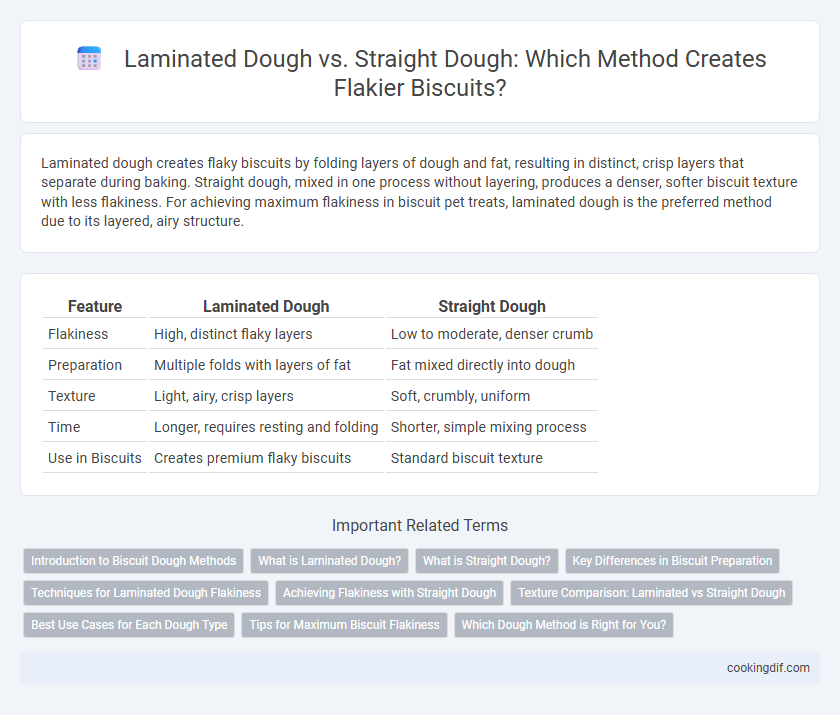Laminated dough creates flaky biscuits by folding layers of dough and fat, resulting in distinct, crisp layers that separate during baking. Straight dough, mixed in one process without layering, produces a denser, softer biscuit texture with less flakiness. For achieving maximum flakiness in biscuit pet treats, laminated dough is the preferred method due to its layered, airy structure.
Table of Comparison
| Feature | Laminated Dough | Straight Dough |
|---|---|---|
| Flakiness | High, distinct flaky layers | Low to moderate, denser crumb |
| Preparation | Multiple folds with layers of fat | Fat mixed directly into dough |
| Texture | Light, airy, crisp layers | Soft, crumbly, uniform |
| Time | Longer, requires resting and folding | Shorter, simple mixing process |
| Use in Biscuits | Creates premium flaky biscuits | Standard biscuit texture |
Introduction to Biscuit Dough Methods
Laminated dough involves folding and layering butter within the dough, creating distinct layers that result in superior flakiness in biscuits. Straight dough method combines all ingredients without layering, producing a more uniform crumb and less pronounced flakiness. Understanding these biscuit dough methods is crucial for achieving desired texture and mouthfeel in biscuit baking.
What is Laminated Dough?
Laminated dough is a type of dough characterized by multiple thin layers of butter folded between layers of dough, creating a flaky texture when baked. This technique contrasts with straight dough, which incorporates fat directly into the dough, resulting in a denser and less flaky biscuit. The lamination process increases steam generation during baking, causing the layers to separate and produce the signature crisp and light flakiness.
What is Straight Dough?
Straight dough is a traditional biscuit-making method where all ingredients--flour, fat, liquid, and leavening agents--are mixed simultaneously, creating a uniform dough. Unlike laminated dough, which involves folding and layering to achieve flakiness, straight dough relies on proper mixing and baking techniques to produce a tender, less flaky texture. This method typically results in denser biscuits with a more consistent crumb structure.
Key Differences in Biscuit Preparation
Laminated dough creates flakier biscuits by incorporating multiple layers of fat and dough through repeated folding and rolling, which traps steam and produces distinct, crisp layers. Straight dough mixes all ingredients at once without layering, resulting in a tender but denser texture with less pronounced flakiness. The key difference lies in the folding process of laminated dough, which enhances flakiness, while straight dough offers simplicity and a softer crumb.
Techniques for Laminated Dough Flakiness
Laminated dough achieves superior flakiness through a meticulous layering technique involving repeated folding and rolling of dough and butter, creating distinct thin layers that separate during baking. Maintaining cold temperatures throughout the process prevents butter melting, ensuring steam production that puffs the layers apart effectively. Precise control of dough elasticity and resting periods between folds enhances layer definition, resulting in a light, crisp texture compared to the denser crumb of straight dough biscuits.
Achieving Flakiness with Straight Dough
Achieving flakiness with straight dough involves careful control of fat incorporation and layering techniques to create distinct layers that separate during baking. Unlike laminated dough, straight dough relies on solid fat pieces distributed throughout the dough, which melt and generate steam, producing a tender and flaky texture. Proper chilling and minimal handling enhance the structure, resulting in biscuits with a delicate, flaky crumb without the complexity of folding layers.
Texture Comparison: Laminated vs Straight Dough
Laminated dough creates multiple thin, alternating layers of fat and dough, resulting in a delicate, flaky texture with distinct, crisp layers ideal for biscuits. Straight dough incorporates all ingredients in a single mix, producing a denser, tender crumb with less pronounced flakiness. The lamination process enhances biscuit flakiness by generating steam pockets during baking, while straight dough offers a softer, more uniform texture.
Best Use Cases for Each Dough Type
Laminated dough, characterized by multiple layers of butter and dough, excels in creating exceptionally flaky and crisp biscuits ideal for pastries like croissants and puff pastries. Straight dough, mixed thoroughly and baked without folding, produces a tender, crumbly texture perfect for classic southern-style biscuits and scones. Bakers choose laminated dough for delicate, layered flakiness while straight dough suits recipes requiring a softer, crumbly bite.
Tips for Maximum Biscuit Flakiness
Laminated dough, created by folding layers of butter into the dough, produces significantly flakier biscuits than straight dough due to the distinct, laminated layers that puff during baking. For maximum biscuit flakiness, keep butter cold and use minimal handling to preserve layers, ensuring the dough stays chilled before baking. Cutting biscuits with a sharp cutter without twisting helps maintain the dough layers' integrity, contributing to superior rise and texture.
Which Dough Method is Right for You?
Laminated dough creates flaky biscuits by incorporating multiple layers of butter and dough, resulting in a delicate, airy texture perfect for those seeking a tender crumb. Straight dough, mixed thoroughly in one step, produces a more uniform, denser biscuit, ideal for quick preparation and consistent results. Choose laminated dough for maximum flakiness and richness, or opt for straight dough when convenience and simplicity are your priorities.
Laminated Dough vs Straight Dough for flakiness Infographic

 cookingdif.com
cookingdif.com